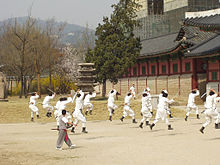- Shippalgi
-
Shippalgi 
Korean name Hangul 십팔기 Hanja 十八技 Revised Romanization Sib Pal Gi McCune–Reischauer Sib Pal Ki Shippalgi (Hangul: 십팔기 Hanja: 十八技 lit: "eighteen techniques") is a kind of Korean martial arts, a system of eighteen traditional martial practices followed in Korea since 1759. These methods are classified into three categories (thrust, slice, and strike) and reflect strong influence from Chinese martial arts and the tactical military situation of the 18th and 19th century before firearms and modern military technology replaced bladed weapons as primary-use in the Korean Army.
Contents
Alternate spellings
Sibpalgi, Sipalki, Sibpalki or Sippalki are also used. The initial sound is "sh" rather than "si" as in "sip," and the final sound is more of a softer "g" than a hard "k."
Korean Martial Background
The Korean system of Shippalgi has its roots in the Korean military manual, Muyejebo (“Martial Arts Illustrations”) which was published in 1610. Conflict with the Japanese during the Imjin War (1592 - 1598) revealed severe shortcomings in the Korean national army causing King Seonjo (1567-1608) to order reforms based on the successful training model of the Chinese General Qi Jiguang (1527 - 1587).
The Muyejebo was compiled by one of the king’s military officers, Han Gyo, and consists of 6 fighting systems. These included the Gonbang (long stick), deungpae (shield), nangseon (multi-tipped spear), jangchang (long spear), dangpa (trident) and the ssangsudo (two-handed saber). During the reign of King Youngjo (1724-1776) the Muyejebo was revised, and supplemented with 12 additional fighting methods by Prince Sado. [1]
Prince Sado also originated the term "Shippalgi" - a shortened term from Bonjo Muye Sib Pal Ban ("18 Martial Arts Classes of the Yi Dynasty")- to identify this collection of skills. The 12 skills that were added include the jukjangchang (long bamboo spear), gichang (flag spear), yedo (short sword), waegeom (Japanese sword), gyojeon (combat engagement with the sword), woldo (crescent sword), hyeopdo (spear sword), ssanggeom (twin swords), jedogeom (Admiral’s Sword), bonguk geom (native sword), gwonbeop (fist method), and pyeongon (flail) for a total of 18 methods. This revised publication was titled the Muyesinbo (“Martial Arts New Illustrations”) and published in 1759.
Both the Muyejebo and Muyesinbo formed the basis for the better known Muyedobotongji.[2]
A modern version of Shippalgi was revitalized by Kim Kwang Suk (김광석, 1936). During the Japanese occupation of Korea, Kim spent his youth in a small Daoist community called Munam in the Korean mountains where he received his training in traditional Korean martial arts from Yun Myeong-Deok. This happened in secret, because the Japanese had outlawed the study of Korean martial arts. He also studied Eastern medicine and breathing exercises. Kim's students founded the Korean Sibpalki Association.
Between 1987 and 2002, Kim published four books about Korean martial arts.
Argentina
Yoo Soo Nam(유수남) has introduced his family style called Ion Bi Ryu ("school of swallow's secrets") to the West beginning in 1970 when he migrated to Argentina, this style has 18 methods, 15 with weapons and the other 3 unarmed. The unarmed methods consists of: personal defense (Ho Sin Sul), combat one to one or one against more than one opponent (Kwon Bop) and Meditation (Shim Bop).
See also
References
External links
- (Korean) The Society for the Preservation of Sippalki
- (Korean) Korean Sibpalki Association
- (Dutch) Netherlands Sibpalki Association
- (Spanish) Argentina
- (Spanish) Escuela de Sipalki Chung Mu - Maestro Jung Hwan Yoon - Argentina
- (Spanish) Escuela de Sipalki DAN BONG KWAN - Maestro ANDRES ESQUIVEL - Argentina
- (Spanish) Escuela de Sipalki - Ion Bi Ryu Mendoza - Argentina
- (English) Mantis Cave, which includes biographies of Sip Pal Gi/Tanglang masters from Korea
- (English) Chun Dae Soung's (noted CMA Sip Pal Gi master) Website
- (English) James Theros' Level 10 Kung Fu Association website's page on Sip Pal Gi
- (English) Park Bok Nam's website, includes a biography of Lu Shui Tian, noted CMA Sip Pal Gi master
- (English) Yong Moon's (noted CMA Sip Pal Gi master) website
- (English) EmptyFlower Forum's thread on Korean CMA and Sip Pal Gi
Korean martial arts Striking Grappling Weaponry Hybrid GongKwon Yusul · Hankido · Han Mu Do · Hapkido · Hwa Rang Do · Kichun · Kouk Sun Do · Kuk Sool Won · Kuk Sul Do · Kung-fu · Kung Jung Mu Sul · Kunmudo · Seon-Kwan-Moo · Shippalgi · TaekkyeonRelated Hyeong · Dobok · Dojang · Kwans · Sae Sok O-Gye · Muyejebo · Muyesinbo · Muyedobotongji · Hwarang · SsaurabiModern Choi Kwang-Do · GongKwon Yusul · Han Mu Do · Hankido · Hankumdo · Hapkido · Kichun · Kong Soo Do · Kouk Sun Do · Kuk Sul Do · Kuk Sool Won · Kumdo · Kung-fu · Kung Jung Mu Sul · Kunmudo · Moo Duk Kwan Taekwondo · Shim Gum Do · Soo Bahk Do · Sunmudo · Taekwondo · Tae Soo Do · Tang Soo DoJoseon Ancient Traditional weapons · SwordsCategories:
Wikimedia Foundation. 2010.
